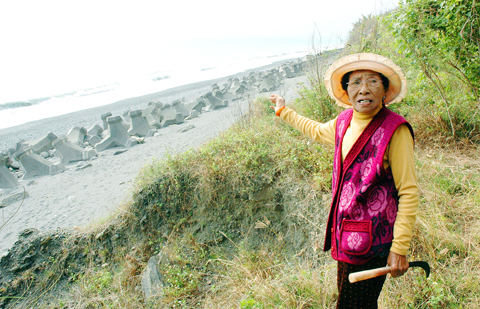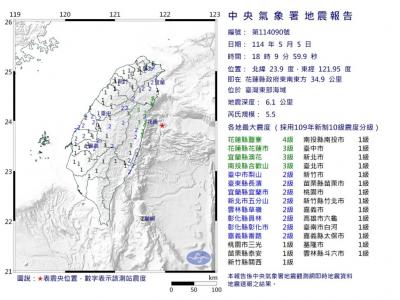Vuvu Cjuku is on a mission. For three years, the 78-year-old woman from the Paiwan tribe has headed to the southeastern coast twice a day to nurse precious pandanus seedlings she hopes will one day regain some of the plant’s former vitality.
Twenty years ago along the coast of Pingtung County’s Dawu Township (大武), there used to be wide, sandy beaches covered with pandanus — palmlike trees with a crown of narrow leaves — but the vegetation has long since disappeared, along with a major portion of the beaches.
What remains is now blighted by rows of concrete breakwaters — artificial blocks attempting to slow down beach erosion.

PHOTO: CNA
Also gone is the seaside house where Cjuku spent her childhood, one that was filled with memories of watching hermit crabs climbing up the pandanus shrubs to eat their fruit and of sea turtles coming ashore to lay their eggs.
“I wonder why all these things are nowhere to be seen now. I want to have them all back to the way they were,” she said.
Not content with simply wondering, she began her ambitious project to restore the vegetation — and consequently help stem erosion at the beach — after discovering what she believed to be the last pandanus tree on the beach three years ago.
She managed to cultivate several cuttings from the tree, but all were swamped when a typhoon hit that summer.
Miraculously, however, one of the seedlings sprouted again the following year, and now there are more than a dozen.
“When they bear fruit, we will be able to grow the trees on a larger scale,” she said.
In the eyes of many, however, the chances of the elderly lady winning her battle against natural forces are slim.
A survey of coastal areas conducted by National Cheng Kung University’s (NCKU) Department of Hydraulic and Ocean Engineering showed that many of the country’s coastal areas have been suffering from severe beach erosion for decades.
Among the worst of these cases, the coast of Kezihliao (蚵子寮) in Kaohsiung County retreated 266m between 1958 and 1987, with a total of 53 hectares of land disappearing. The shore just south of the central port of Taichung retreated 212m between 1983 and 1996, with land totaling 189 hectares disappearing.
The coast along Tainan County’s Chiku Township (七股), meanwhile, retreated 429m between 1961 and 2000.
In eastern areas, retreats of 100m were seen along the coast of Ilan County’s Toucheng Township (頭城) between 1999 and last year, 84m along Hualien County’s coast of Nanbin (南濱) and Beibin (北濱) between 1984 to 1992 and 78m south of Taitung County’s Dawu fishing port between 1978 and last year.
While waves are the primary natural force leading to erosion, some geologists believe the situation has been exacerbated by rising sea levels — a result of global warming.
Another culprit is the sharp decline in sediment volume in estuaries, the result of excessive river sand extraction and the building of reservoirs and dams that have blocked the transport of sediment needed to replenish beaches.
Hsu Tai-wen (許泰文), director of the Department of Hydraulic and Ocean Engineering at NCKU, which is conducting coastal surveys for the Water Resources Agency (WRA), said that suspended sand particles fed by those estuaries and transported by currents along the coast are the main resource for beach formation.
Erosion occurs when the upcurrent amount of sediment is less than the amount being carried away.
“The beaches are lost for good in the event of scanty deposits,” Hsu said.
In the past three years, the WRA has adopted measures to control river sand extraction and now river sand accounts for only 40 percent of the sand used in domestic construction projects, down from as much as 90 percent during the economic boom in the 1980s and 1990s.
Those efforts, however, have yet to show obvious benefits, Hsu said.
“It takes time. But at least we can see that the situation is not worsening,” Hsu said. “The retreat of the coastline, while continuing over the last 10 years, is not as drastic as during the previous decade.”
Another man-made cause of erosion is the extensive development of coastal areas. Data from the Construction and Planning Agency under the Ministry of the Interior showed that nearly 56 percent of Taiwan’s 1,349km coastline is occupied by manmade facilities, including more than 200 fishing, commercial and military ports.
Most ports are protected against sea surges by barriers that project into the ocean, such as jetties and seawalls. As these barriers interrupt the flow of suspended sand particles, sand accumulates on the upcurrent side of the seawall but fails to reach the other side, causing severe erosion, Hsu said.
Liao Wen-hung (廖文弘), a technical specialist in the agency’s Planning Division, which is running a government coastal monitoring program, said the phenomenon, called the “groin effect,” is seen around all coastal facilities in Taiwan.
Toucheng Beach in Ilan, which once stretched for 2km and had a total area equal to 60 football fields — is one such casualty. It has been vanishing since the construction more than 10 years ago of protective jetties at the Wushih fishing harbor, located just north of the beach.
For several years, the WRA has been attempting to nourish the beach by building barriers there to help accumulate sand, with little success.
Hsu said soft engineering options such as beach nourishment were better for dealing with coastal erosion despite their slow progress and high costs because they do less damage to the natural landscape.
Beach nourishment projects, however, remain rare. The first and best-known case was completed last year in Sizihwan (西子灣), Kaohsiung City, where a 5 hectare beach was restored through sand fill and a headland project to extend the life of the fill.
A similar project is currently under way near the port of Anping, Tainan.
The planting of vegetation such as pandanus and beach morning glory, which are known for their beach-stabilizing functions, should come only after lost beaches have successfully been restored by artificial means, Hsu said, a cautionary warning to the committed Vuvu Cjuku.
“If pandanus trees are grown when the beach is already gone, the sea will still swamp the area, killing the trees very quickly,” he said.

An essay competition jointly organized by a local writing society and a publisher affiliated with the Chinese Communist Party (CCP) might have contravened the Act Governing Relations Between the People of the Taiwan Area and the Mainland Area (臺灣地區與大陸地區人民關係條例), the Mainland Affairs Council (MAC) said on Thursday. “In this case, the partner organization is clearly an agency under the CCP’s Fujian Provincial Committee,” MAC Deputy Minister and spokesperson Liang Wen-chieh (梁文傑) said at a news briefing in Taipei. “It also involves bringing Taiwanese students to China with all-expenses-paid arrangements to attend award ceremonies and camps,” Liang said. Those two “characteristics” are typically sufficient

A magnitude 5.9 earthquake that struck about 33km off the coast of Hualien City was the "main shock" in a series of quakes in the area, with aftershocks expected over the next three days, the Central Weather Administration (CWA) said yesterday. Prior to the magnitude 5.9 quake shaking most of Taiwan at 6:53pm yesterday, six other earthquakes stronger than a magnitude of 4, starting with a magnitude 5.5 quake at 6:09pm, occurred in the area. CWA Seismological Center Director Wu Chien-fu (吳健富) confirmed that the quakes were all part of the same series and that the magnitude 5.5 temblor was

The brilliant blue waters, thick foliage and bucolic atmosphere on this seemingly idyllic archipelago deep in the Pacific Ocean belie the key role it now plays in a titanic geopolitical struggle. Palau is again on the front line as China, and the US and its allies prepare their forces in an intensifying contest for control over the Asia-Pacific region. The democratic nation of just 17,000 people hosts US-controlled airstrips and soon-to-be-completed radar installations that the US military describes as “critical” to monitoring vast swathes of water and airspace. It is also a key piece of the second island chain, a string of

The Central Weather Administration has issued a heat alert for southeastern Taiwan, warning of temperatures as high as 36°C today, while alerting some coastal areas of strong winds later in the day. Kaohsiung’s Neimen District (內門) and Pingtung County’s Neipu Township (內埔) are under an orange heat alert, which warns of temperatures as high as 36°C for three consecutive days, the CWA said, citing southwest winds. The heat would also extend to Tainan’s Nansi (楠西) and Yujing (玉井) districts, as well as Pingtung’s Gaoshu (高樹), Yanpu (鹽埔) and Majia (瑪家) townships, it said, forecasting highs of up to 36°C in those areas